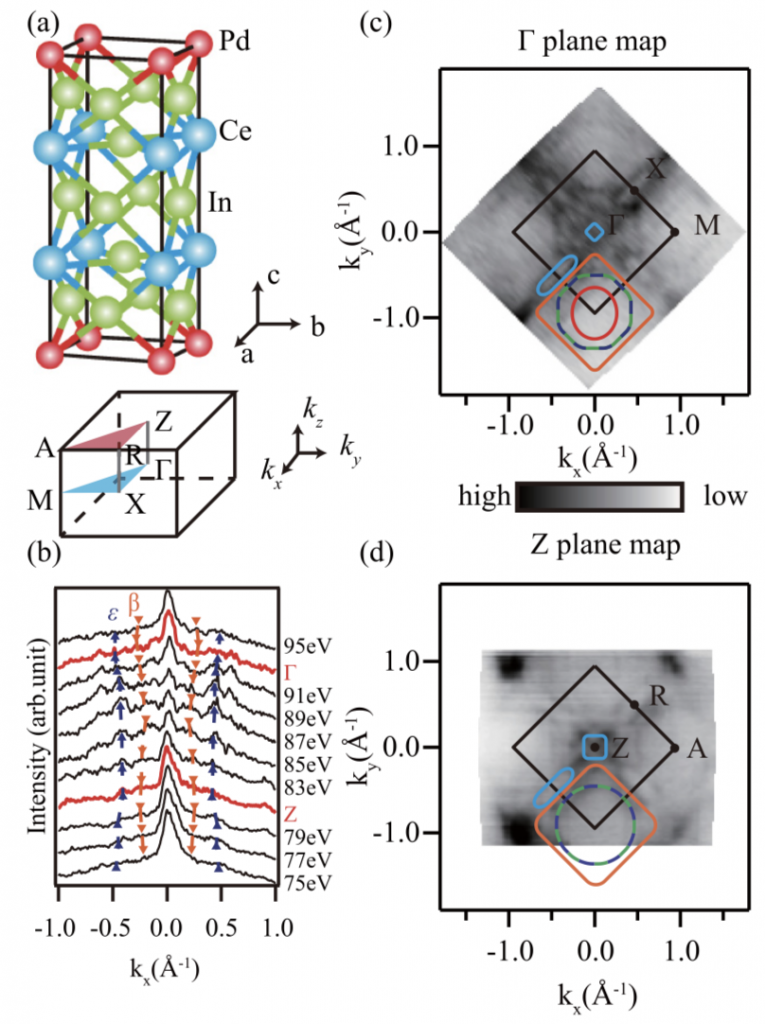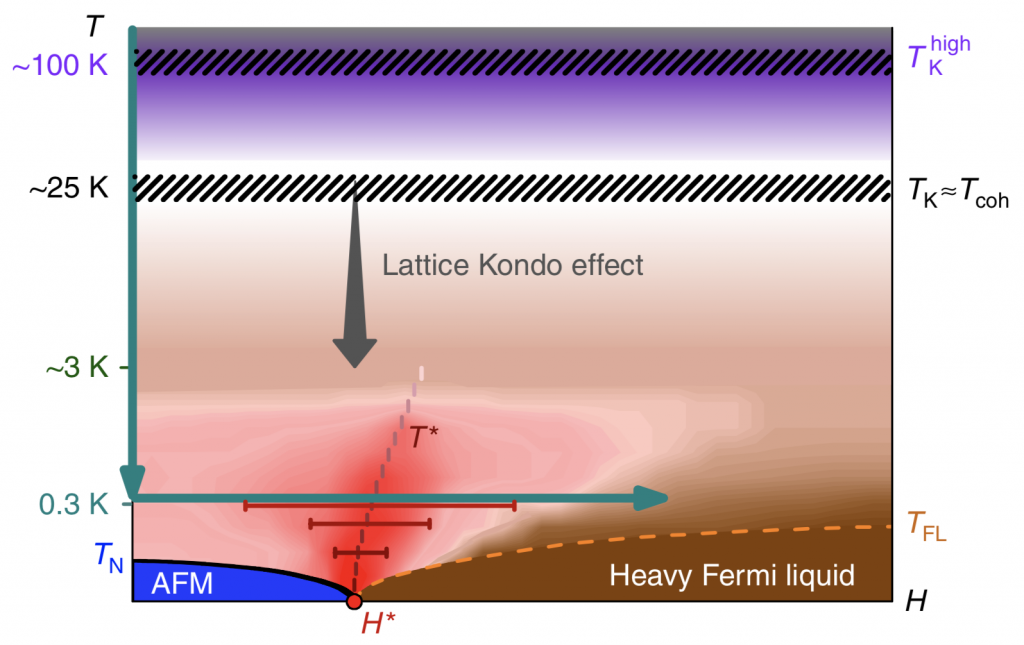A major objective of research on correlated quantum materials is to link the characteristic properties to the features of the ground state and the excitation spectrum above it. A major aim is to be able to understand and predict the emergence of novel phases in quantum matter. The quest for a unified understanding of different classes of quantum materials has led to the notion of quantum criticality which offers an economic and powerful way of rationalizing their phase diagrams.
Among the materials classes that are particularly interesting are the cuprates, iron pnictides, pyrochlore iridates, transition metal dichalcogenides, and heavy electron compounds. An underlying theme in these materials classes is the tendency of their charge carriers to localize in response to the large effective Coulomb repulsion experienced by the itinerant degrees of freedom.
Highlights
“Electronic structure and 4f-electron character in Ce2PdIn8 studied by angle-resolved photoemission spectroscopy“
Q. Yao, D. Kaczorowski, C. H. P. Wen, X. H. Niu, R. Peng, H. C. Xu, P. Dudin, S. Kirchner, Q. Y. Chen, D. W. Shen, and D. L. Feng
Phys. Rev. B 99, 081107(R) (2019)
The localized-to-itinerant transition of f electrons lies at the heart of heavy-fermion physics, but has only been directly observed in single-layer Ce-based materials. Here, we report a comprehensive study on the electronic structure and nature of the Ce 4f electrons in the heavy-fermion superconductor Ce2PdIn8, a typical n=2 CenMmIn3n+2m compound, using high-resolution and 4d−4f resonant photoemission spectroscopies. The electronic structure of this material has been studied over a wide temperature range, and hybridization between f and conduction electrons can be clearly observed to form a Kondo resonance near the Fermi level at low temperatures. The characteristic temperature of the localized-to-itinerant transition is around 120 K, which is much higher than its coherence temperature Tcoh∼30K.

(a) Crystal structure and the three-dimensional Brillouin zone of tetragonal Ce2PdIn8. (b) Momentum distribution curves taken with 75–95 eV photons along M--M. (c), (d) Photoemission intensity and Z maps of Ce2PdIn8 at EF , taken with 80- and 93-eV photon energies,respectively.Theintensitywasintegratedover(EF −10meV,EF +10meV).
“Evolution of the Kondo lattice and non-Fermi liquid excitations in a heavy-fermion metal”
S. Seiro, L. Jiao, S. Kirchner, S. Hartmann, S. Friedemann, C. Krellner, C. Geibel, Q. Si, F. Steglich, and S. Wirth
Nature Communications 9, 3324 (2018)
Strong electron correlations can give rise to extraordinary properties of metals with renormalized Landau quasiparticles. Near a quantum critical point, these quasiparticles can be destroyed and non-Fermi liquid behavior ensues. YbRh2Si2 is a prototypical correlated metal exhibiting the formation of quasiparticle and Kondo lattice coherence, as well as quasiparticle destruction at a field-induced quantum critical point. Here we show how, upon lowering the temperature, Kondo lattice coherence develops at zero field and finally gives way to non-Fermi liquid electronic excitations. By measuring the single-particle excitations through scanning tunneling spectroscopy, we find the Kondo lattice peak displays a non trivial temperature dependence with a strong increase around 3.3 K. At 0.3 K and with applied magnetic field, the width of this peak is minimized in the quantum critical regime. Our results demonstrate that the lattice Kondo correlations have to be sufficiently developed before quantum criticality can set in.

Phase diagram of YbRh2Si2. Schematic temperature–magnetic field phase diagram as inferred from magnetotransport, magnetostriction, and magnetization measurements at low T, and STM measurements down to ~5 K. The QCP (red dot) is located at H* ≈ 0.06 T for H⊥c and H ≈ 0.66 T for H||c. The single-ion Kondo temperatures TK^{high} and TK involve all (purple shading) and the lowest-lying (white) crystal electric field levels, respectively. The lattice Kondo effect starts to develop around Tcoh ≈ TK.
“Two-Channel Kondo Physics due to As Vacancies in the Layered Compound ZrAs1.58Se0.39”
T. Cichorek, L. Bochenek, M. Schmidt, R. Niewa, A. Czulucki, G. Auffermann, Frank Steglich, R. Kniep, and Stefan Kirchner
Phys. Rev. Lett. 117, 106601 (2016)
We address the origin of the magnetic-field-independent −|A|T^1/2 term observed in the low-temperature resistivity of several As-based metallic systems of the PbFCl structure type. For the layered compound ZrAs1.58Se0.39, we show that vacancies in the square nets of As give rise to the low-temperature transport anomaly over a wide temperature regime of almost two decades in temperature. This low-temperature behavior is in line with the nonmagnetic version of the two-channel Kondo effect, whose origin we ascribe to a dynamic Jahn-Teller effect operating at the vacancy-carrying As layer with a C4 symmetry. The pair- breaking nature of the dynamical defects in the square nets of As explains the low superconducting transition temperature Tc ≈ 0.14 K of ZrAs1.58Se0.39 compared to the free-of-vacancies homologue ZrP1.54S0.46(Tc ≈ 3.7 K). Our findings should be relevant to a wide class of metals with disordered pnictogen layers.

Structural disorder in zirconium pnictide chalcogenides. (a) The PbFCl structure type with the fully occupied Q(2c) site (green) by Ch together with Pn. The Pnð2aÞ site (blue) arranged within planar layers is only occupied to 97% by As in ZrAs1.58 Se0.39 , but it is fully occupied by P in ZrP1.54 S0.46 . (b) The vacancies in ZrAs1.58Se0.39 (left panel) manifest random displacements of As within the layer due to homoatomic covalent bond formation. This is indicated by flattened displacement ellipsoids in the structure refinements, while the refined displace- ment ellipsoids in ZrP1.54S0.46 (right panel) are nearly spherical.